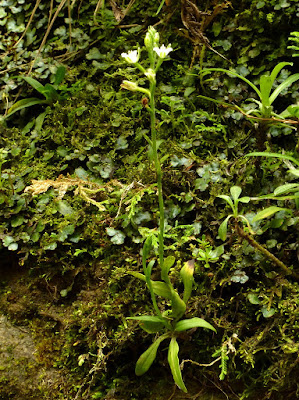Ponthieva racemosa is a widespread and popular orchid, whose occurrence stretches from the south-eastern US states through Mexico, Central America, the Caribbean, to South America from Colombia and Venezuela and further south to the west of Brazil...
Ponthieva racemosa also called as The Racemose Ponthieva, The Hairy Shadow Witch, Arethusa racemosa, Cranichis multiflora, Epipactis pubescens, Listera pubescens, Neottia glandulosa, Neottia pubera, Nerissa glandulosa, Ponthieva costaricensis, Ponthieva glandulosa, Ponthieva glandulosa var. macra, Ponthieva guatemalensis, Ponthieva lancifolia, Ponthieva oblongifolia, Serapias pubescens, is a species of the genus Ponthieva. This species was described by Charles Mohr in 1901.
IDENTIFY PONTHIEVA RACEMOSA
Ponthieva racemosa is a widespread and popular orchid, whose occurrence stretches from the south-eastern US states through Mexico, Central America, the Caribbean, to South America from Colombia and Venezuela and further south to the west of Brazil. In the United States, it is found on the coastal lowlands from Virginia to Florida, further west to states along the Gulf of Mexico to southeastern Texas. These areas include all of Florida, the Bahamas, Cuba and all Caribbean islands. The natural habitats stretch south along both coasts of Mexico from the border with Texas and further through Central America. In Guatemala, these plants were found near Cobán in the department of Alta Verapaz, between Canquintie and Subajasún in the department of Huehuetenango, in several other locations, and near Chichicastenange in the Province of Quiché. In this region, they are found in shady, humid places, in forests on clay slopes, on wet cliffs and in forests along streams, at altitudes up to 2000 m. In Panama, these orchids were encountered on the Chiriquí volcano in the Chiriquí Province, at altitudes of 3500-4000 m, in the Province of Coclé near El Valle at an altitude of 600-1000 m, and in the Province of Panama at the San Juan section at sea level. In Venezuela, they are found in many locations, mainly in damp areas, in the states of Aragua, Anzoategui, Miranda and near Caracas in the Federal District, at heights of 800-2200 m.
It is a small to medium sized, hot to cool growing terrestrial with a basal rosette of broad, variable, elliptic to lanceolate to obovate, acute, petiolate, glabrous, 4-30 cm long and 1.5-6.0 cm wide leaves.
The Racemose Ponthieva blooms in the winter and early spring on an erect, pubescent, to 25 cm long, few to many flowered, racemose inflorescence with prominent bracts. The small flowers are 1.25 cm in diameter and have a lip directed upwards, and the whitish-green petals of both whorls have emerald green veins. The slightly rounded lip is white with a green, deeply concave middle. It has a short, narrow claw at the base, and at the apex it narrows rapidly to form a sharp, triangular appendage.
PONTHIEVA RACEMOSA CARE AND CULTURE
Cultural information should only be used as a guide, and should be to be adapted to suit you. Your physical location; where you grow your plants, how much time you have to devote to their care, and many other factors, will need to be taken into account. Only then can you decide on the cultural methods that best suit you and your plants.
Light:
Ponthieva racemosa needs a light level of 20000-30000 lux. The light should be slightly filtered or scattered, and the plants should never be exposed to the direct effects of the midday sun. Strong air movement should be ensured all the time.
Temperature:
The average temperature of the summer day is 25-26 ° C, the night 15-16 ° C, and the daily difference is 9-11 ° C. The average temperature of the winter day is 23-24 ° C, the night 11-12 ° C, and the daily difference is 11-13 ° C.
Humidity:
The Racemose Ponthieva needs the average humidity is 80-85% throughout the year.
Substrate, growing media and repotting:
When growing in pots or at rebates, excellent drainage is required. The substrate should be slightly acidic, and the plants grown in pots with a well-drying, sandy soil, to which sphagnum chopped and finely chopped wood fern fibers are added.
Watering:
Throughout the year, rainfall is moderate to heavy, only 2-3 winter months are slightly drier. The cultivated plants should be abundantly watered during active growth, but the substrate around the roots can never be soggy or stale.
Fertilizer:
It is recommended to apply a 1/4-1/2 dose of fertilizer for orchids every week in the growing season. You can use sustainable fertilizer throughout the year; or use high-nitrogen fertilizer from spring to mid-summer, and then high-phosphoric fertilizer until the end of autumn.
Rest period:
In winter, the amount of water for Ponthieva racemosa should be reduced, especially those growing in the conditions of a short, dark day at moderate latitudes. The substrate should then be kept slightly moist, and the plants can never completely dry out. Fertilization should be eliminated until new growths appear in the spring, when more watering begins. If the plants grow on rebates in areas where temperatures reach below 0 ° C, in the fall should be cut gains, and plants cover with a thick layer of mulch protecting against the cold.

















COMMENTS